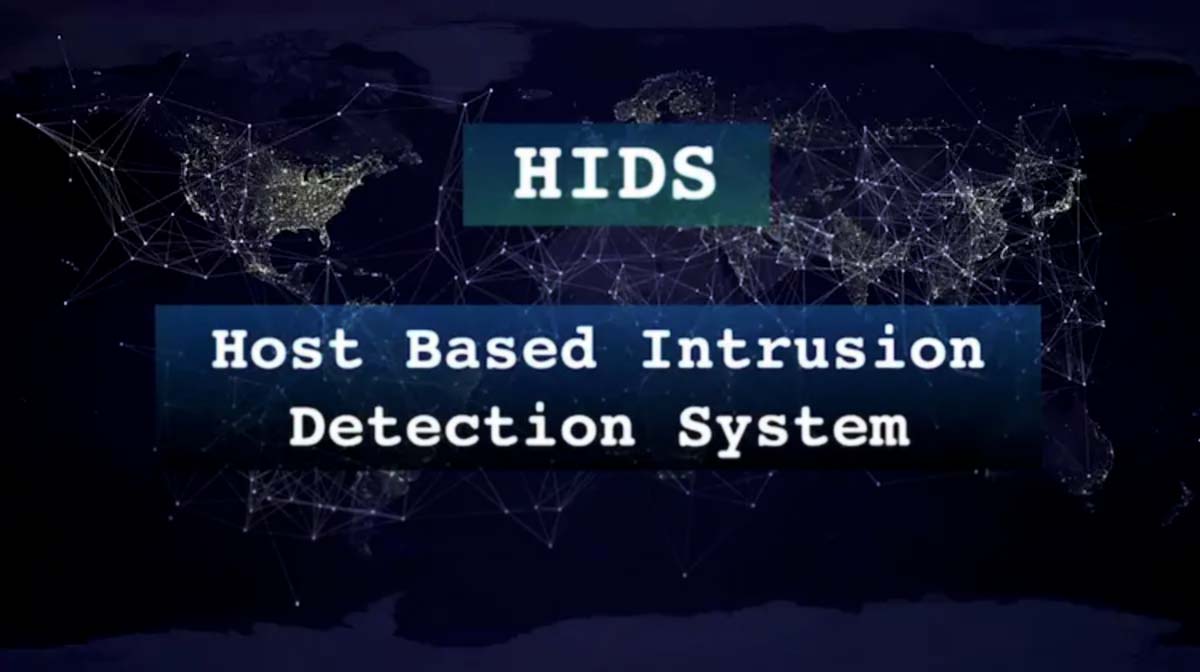Home>Home Security and Surveillance>What Is OSSEC Intrusion Detection System


Home Security and Surveillance
What Is OSSEC Intrusion Detection System
Modified: August 29, 2024
Discover the benefits of OSSEC Intrusion Detection System for home security and surveillance. Protect your home and loved ones with advanced threat detection and response capabilities.
(Many of the links in this article redirect to a specific reviewed product. Your purchase of these products through affiliate links helps to generate commission for Storables.com, at no extra cost. Learn more)
Introduction
Home security and surveillance have become essential aspects of modern living. As the world becomes more interconnected, the need to protect our homes from potential threats has never been greater. From break-ins and theft to vandalism and intrusion, staying one step ahead of criminals is of utmost importance.
One effective way to enhance home security is by utilizing an intrusion detection system (IDS). An IDS is designed to monitor and analyze network activity, detecting any unauthorized or suspicious behavior. It acts as a virtual watchdog, constantly vigilant in identifying potential security breaches.
In this article, we will explore the OSSEC Intrusion Detection System, a powerful and versatile tool for safeguarding your home. We will delve into its features, architecture, installation, configuration, alerts and log analysis, rules and policy management, integration with other security tools, as well as its benefits and limitations.
By the end of this article, you will have a comprehensive understanding of how OSSEC IDS operates and how it can bolster the security of your home. Let’s dive in!
Key Takeaways:
- OSSEC IDS is a powerful tool for home security, offering real-time monitoring, active response capabilities, and centralized management. It can detect potential threats and integrate with other security tools for enhanced protection.
- While OSSEC IDS provides valuable benefits, such as flexibility and integration capabilities, it also has limitations, including complexity of configuration and the need for ongoing maintenance. Administrators must consider these factors to effectively leverage its features.
Overview of OSSEC Intrusion Detection System
The OSSEC Intrusion Detection System, commonly referred to as OSSEC IDS, is an open-source platform designed to provide comprehensive security monitoring and threat detection for home environments. It was created by Daniel Cid in 2004 and has since gained popularity due to its robust features and community support.
OSSEC IDS is built on a client-server architecture and is compatible with various operating systems, including Windows, Linux, macOS, and Unix. It offers real-time log analysis, file integrity checking, centralized event correlation, and active response capabilities.
One of the key benefits of OSSEC IDS is its ability to monitor multiple devices and network infrastructure from a central location. Whether you have security cameras, smart locks, or IoT devices, OSSEC IDS can aggregate and analyze the logs generated by these devices, providing a holistic view of your home security status.
The system operates by collecting and analyzing log data from various sources, such as system and application logs, network traffic logs, and user activity logs. OSSEC IDS uses predefined rules and policies to identify potential security incidents. When a suspicious event is detected, OSSEC IDS can trigger automated responses, such as blocking IP addresses, sending email notifications, or running custom scripts.
OSSEC IDS uses a combination of signature-based detection, anomaly detection, and correlation analysis to identify security breaches. Signature-based detection compares log data against a database of known attack patterns, while anomaly detection looks for behavior that deviates from normal patterns. Correlation analysis connects related events and identifies potential attack scenarios.
Another noteworthy feature of OSSEC IDS is its integration with third-party security tools. It supports integration with popular security information and event management (SIEM) systems, allowing you to centralize and manage security events from multiple sources in one location. This integration enhances the overall effectiveness of your security monitoring and incident response.
Now that we have a high-level understanding of OSSEC IDS, let’s delve deeper into its features and explore how it can improve your home security and surveillance.
Features of OSSEC IDS
OSSEC IDS offers a wide range of features that make it a powerful tool for home security and surveillance. Let’s delve into some of its key features:
- Real-time Log Analysis: OSSEC IDS monitors and analyzes log files in real-time, providing instant visibility into potential security incidents. It supports log files from various sources, including servers, network devices, operating systems, applications, and databases.
- File Integrity Monitoring: OSSEC IDS helps ensure the integrity of critical system files by monitoring and detecting any unauthorized changes. It calculates and maintains checksums of important files and alerts you if any modifications are detected.
- Active Response: OSSEC IDS can take immediate action in response to security events. It can block malicious IP addresses, execute custom scripts, and send email alerts. This proactive approach helps mitigate potential threats and prevents further compromises.
- Centralized Management: OSSEC IDS allows for centralized management of multiple devices and security sensors. Whether you have a single home network or multiple locations, OSSEC IDS provides a unified view of your security posture, making it easier to monitor and respond to threats.
- Security Event Correlation: OSSEC IDS analyzes and correlates security events from various sources to identify patterns and potential attack scenarios. This feature helps you gain a comprehensive understanding of your security landscape and prioritize response efforts.
- Customizable Rules and Policies: OSSEC IDS allows you to fine-tune its behavior based on your specific security requirements. You can create custom rules and policies to detect and respond to unique threats and scenarios in your home environment.
- Integration with SIEM Systems: OSSEC IDS integrates seamlessly with Security Information and Event Management (SIEM) systems, enabling centralized event management, log aggregation, and advanced analytics. This integration enhances your ability to monitor and respond to security incidents across your entire home network.
- Scalability and Flexibility: Whether you have a small home network or a complex setup, OSSEC IDS can scale to meet your needs. It supports distributed architectures and can handle large volumes of security events, ensuring that you don’t miss any critical alerts.
These are just a few of the many features that make OSSEC IDS an excellent choice for enhancing home security and surveillance. By leveraging these capabilities, you can strengthen the security posture of your home network and ensure peace of mind for you and your loved ones.
Architecture of OSSEC IDS
The architecture of OSSEC IDS is based on a client-server model, which allows for flexible and scalable deployment in various home security environments. Let’s take a closer look at the components that make up the architecture:
- OSSEC Server: The OSSEC server is the central component of the IDS. It is responsible for receiving and processing security events from connected devices, performing log analysis, and triggering responses based on predefined rules and policies.
- OSSEC Agents: OSSEC agents are installed on client devices within the home network. These agents collect relevant log files and send them securely to the OSSEC server for analysis. The agents can be installed on servers, workstations, routers, or any other device that generates security event logs.
- OSSEC Database: The OSSEC database stores the collected security events and associated metadata. This allows for easy querying, reporting, and analysis of historical data. It can be integrated with external databases or SIEM systems for advanced correlation and analysis.
- OSSEC Web Interface: The OSSEC web interface provides a graphical interface for managing and monitoring the OSSEC IDS. It allows administrators to view real-time alerts, manage rules and policies, and analyze the security event logs. The web interface provides a user-friendly experience and simplifies the management of OSSEC IDS.
- Third-Party Integrations: OSSEC IDS can integrate with various third-party security tools and systems, such as SIEM platforms, threat intelligence feeds, and log management solutions. This integration enhances the capabilities and effectiveness of the IDS by leveraging additional security data sources and analysis tools.
The communication between the OSSEC agents and the OSSEC server is secured using encrypted channels, ensuring the confidentiality and integrity of the data being transmitted. The agents periodically send the collected logs to the server, where they are processed and analyzed against the predefined rules and policies.
When a security event is detected, the OSSEC server generates an alert and can take active response actions. These responses can include blocking IP addresses, sending notifications to administrators, executing custom scripts, or interacting with external systems through integrations. The alerts and responses provide administrators with real-time information and enable them to respond promptly to potential security threats.
The architecture of OSSEC IDS allows for easy scalability and flexibility. Additional agents can be deployed as needed to monitor new devices or expand the coverage of the IDS. The centralized management provided by the OSSEC server and web interface simplifies the configuration and administration of the IDS across multiple devices and locations.
With its robust architecture, OSSEC IDS provides a solid foundation for securing and monitoring your home network, keeping you informed and protected against potential security breaches.
Installation and Configuration
Installing and configuring OSSEC IDS for your home security and surveillance needs is a straightforward process. Let’s go through the steps involved:
- Step 1: Download and Install OSSEC: Start by downloading the OSSEC package from the official website. Ensure that you choose the version compatible with your operating system. Follow the installation instructions provided for your specific platform, which may include running an installer or executing command-line commands.
- Step 2: Choose Server or Agent Installation: Decide whether you want to install OSSEC as a server or an agent. The server should be installed on a centralized machine that will receive and process security events. Agents should be installed on the devices that generate logs and need to be monitored.
- Step 3: Server Configuration: If you chose to install OSSEC as a server, you need to configure it. This involves setting up the server IP address, listening ports, database integration, email settings, and other optional parameters. Refer to the OSSEC documentation for detailed instructions on how to configure the server.
- Step 4: Agent Registration: For each device that will serve as an agent, you need to register it with the OSSEC server. This involves providing the server IP address, authentication key, and specific agent details. The OSSEC documentation provides instructions on how to register agents using the
ossec-authdtool or manually editing the agent’s configuration file. - Step 5: Agent Configuration: Once the agents are registered, you can configure them to specify which logs to monitor and how to behave in response to security events. You can define log files, directories, and other log sources to be monitored. You can also customize rules and policies to suit your specific security requirements.
- Step 6: Testing and Monitoring: After the installation and configuration are complete, it’s essential to test the setup and ensure that logs are being collected and analyzed correctly. Generate security events on the monitored devices and verify that the server receives and processes them, triggering appropriate alerts or responses.
- Step 7: Ongoing Maintenance: After the initial installation and configuration, it is important to regularly monitor the OSSEC IDS, update the software to the latest version, and fine-tune the rules and policies based on emerging security threats. Monitor the OSSEC server web interface for alerts and adjust configuration settings as necessary.
It’s important to note that while the installation and configuration process may vary depending on your operating system and specific requirements, the general steps outlined above should give you a solid foundation for getting started with OSSEC IDS.
By properly installing and configuring OSSEC IDS, you can ensure that your home security and surveillance system is up and running, actively monitoring and protecting your network from potential threats.
Alerts and Log Analysis in OSSEC IDS
Alerts and log analysis are crucial components of OSSEC IDS, providing valuable insights into potential security incidents within your home network. Let’s explore how OSSEC IDS handles alerts and performs log analysis:
Alerts:
OSSEC IDS generates alerts when it detects security events that violate predefined rules and policies. These alerts serve as notifications to administrators, indicating potential security breaches. There are several types of alerts that OSSEC IDS can generate:
- Rule-Based Alerts: OSSEC IDS uses a wide range of predefined rules to identify common security threats. These rules are based on known attack patterns, vulnerabilities, and abnormal behaviors. When a rule is triggered, an alert is generated, providing details about the event, such as the source IP address, targeted system, and the nature of the activity.
- Real-Time Alerts: OSSEC IDS provides real-time alerting capabilities, ensuring that administrators are promptly informed of potential threats. As soon as a security event is detected, an alert is generated and displayed in the OSSEC server’s web interface. This allows administrators to take immediate action to mitigate the risk and investigate further.
- Active Response Alerts: In addition to generating alerts, OSSEC IDS can also trigger active responses in response to security events. These responses can include blocking IP addresses, running custom scripts, or sending email notifications. Active response alerts provide an additional layer of protection by proactively defending against potential threats.
Log Analysis:
OSSEC IDS performs comprehensive log analysis to identify security incidents and patterns within the collected log data. The log analysis process involves several steps:
- Log Collection: OSSEC IDS collects log data from various sources, including system logs, application logs, network traffic logs, and user activity logs. These logs are aggregated and stored for analysis.
- Log Parsing: The collected logs are parsed and transformed into a standardized format, allowing for easy analysis and correlation. OSSEC IDS supports log parsing for a wide range of log formats, ensuring compatibility with various types of log sources.
- Rule Matching: OSSEC IDS compares the parsed log data against predefined rules and policies. These rules define known attack patterns, abnormal behaviors, or specific log patterns associated with security incidents. When a rule is matched, an alert is generated, indicating a potential security event.
- Event Correlation: OSSEC IDS performs event correlation by analyzing related security events and identifying potential attack scenarios. This helps administrators gain a deeper understanding of the security landscape and prioritize their response efforts.
- Historical Analysis: OSSEC IDS stores the collected logs and associated metadata in a database, allowing for historical analysis. Administrators can query the database, generate reports, and perform trend analysis to identify recurring patterns and potential security trends over time.
By effectively analyzing logs and generating alerts, OSSEC IDS equips administrators with the necessary information to take proactive measures against potential security threats. The combination of real-time alerts and comprehensive log analysis ensures that no suspicious activity goes unnoticed within your home network.
Rules and Policy Management in OSSEC IDS
Rules and policy management is a critical aspect of OSSEC IDS, as it enables administrators to customize the behavior of the system and tailor it to their specific home security needs. Let’s explore how OSSEC IDS handles rules and policies:
Read more: What Is Wireless Intrusion Detection
Rules:
OSSEC IDS uses rules to define the specific conditions and criteria for identifying security events. The rules are preconfigured to detect common attack patterns, abnormal behaviors, and system vulnerabilities. However, administrators have the flexibility to modify existing rules or create custom rules to address unique threats in their home environments.
OSSEC IDS provides a rule syntax that allows administrators to define rules using a combination of pattern matching, regular expressions, and logical operators. Rules can be applied to specific log sources, log files, or log patterns. Administrators can specify actions to be taken when a rule is matched, such as generating alerts, sending notifications, or triggering active responses.
The rule management in OSSEC IDS is highly customizable, allowing administrators to fine-tune the system’s behavior to their specific needs. By continuously updating and refining the rules, administrators can enhance the accuracy and effectiveness of the IDS in detecting and responding to security threats.
Policies:
In addition to rules, OSSEC IDS utilizes policies to define the overall behavior and configuration of the system. Policies specify how OSSEC IDS handles specific security events and define the responses to be triggered based on rule matches.
Administrators can configure policies to determine whether an alert should be generated, what actions should be taken, and the severity level assigned to different types of security events. Policies also allow administrators to specify exceptions or overrides to certain rules, enabling them to customize the behavior of the IDS for specific log sources or devices.
OSSEC IDS supports granular policy management, allowing administrators to assign different policies to specific groups of agents or devices. This flexibility enables administrators to tailor the behavior of the IDS to different segments of their home network, based on specific security requirements or sensitivity levels of the devices.
Effective rule and policy management is crucial for optimizing the performance and effectiveness of OSSEC IDS. By continuously reviewing and updating rules and policies, administrators can ensure that the IDS is accurately detecting security events and taking the appropriate actions in response to potential threats.
OSSEC IDS provides a user-friendly interface for managing rules and policies, allowing administrators to easily customize and fine-tune the behavior of the IDS based on their home security needs.
Integration with Other Security Tools
OSSEC IDS offers seamless integration with other security tools and systems, enhancing its effectiveness and extending its capabilities in safeguarding your home network. Let’s explore the various ways OSSEC IDS can be integrated with other security tools:
Security Information and Event Management (SIEM) Systems:
OSSEC IDS can integrate with popular SIEM systems, such as Splunk, ELK Stack (Elasticsearch, Logstash, Kibana), or IBM QRadar. This integration allows for centralized event management, log aggregation, and advanced analytics. By forwarding security event logs from OSSEC IDS to a SIEM system, administrators can gain a holistic view of the security landscape, leverage advanced correlation capabilities, and benefit from extensive reporting and visualization features.
Read more: How To Test Intrusion Detection System
Threat Intelligence Feeds:
Integrating OSSEC IDS with threat intelligence feeds enhances its ability to detect and respond to emerging threats. Threat intelligence feeds provide up-to-date information on known malicious IP addresses, domains, and other indicators of compromise. By incorporating these feeds into OSSEC IDS, administrators can automatically block or flag connections to known malicious entities, bolstering the security of their home network.
Vulnerability Scanners:
OSSEC IDS can be integrated with vulnerability scanners, such as OpenVAS or Nessus, to combine the capabilities of both tools. By correlating OSSEC IDS alerts with vulnerability scan results, administrators can prioritize their remediation efforts and identify potential security vulnerabilities that may have been exploited or attempted within their home network.
Network Intrusion Prevention Systems (NIPS):
Integration with NIPS solutions such as Snort or Suricata allows OSSEC IDS to enhance its capabilities in detecting and preventing network-based attacks. By leveraging the intrusion detection features of OSSEC IDS in combination with the intrusion prevention capabilities of NIPS, administrators can create a robust defense strategy, actively blocking suspicious traffic and reducing the risk of successful attacks.
Log Management Solutions:
OSSEC IDS can integrate with log management solutions like Logstash or Graylog. This integration enables centralized log storage, search, and analysis capabilities. By forwarding OSSEC IDS logs to a dedicated log management system, administrators can simplify log retention, automate log analysis, and leverage advanced search and visualization features to gain deeper insights into the security events within their home network.
These are just a few examples of how OSSEC IDS can integrate with other security tools to enhance its capabilities in protecting your home network. Integration with these tools allows for a more comprehensive and efficient security posture, leveraging the strengths of each system to create a unified and robust defense mechanism.
When considering integration with other security tools, it is essential to ensure compatibility and consider the specific requirements of your home network environment. Depending on your needs, you can select the most appropriate tools and integration methods to create a tailored and effective security solution.
Read more: How To Create Intrusion Detection System
Benefits and Limitations of OSSEC IDS
OSSEC IDS offers several benefits that make it a valuable tool for enhancing home security and surveillance. However, like any system, it also has certain limitations. Let’s explore the benefits and limitations of OSSEC IDS:
Benefits:
- Real-Time Threat Detection: OSSEC IDS provides real-time monitoring and analysis of security events, ensuring prompt detection and response to potential threats within your home network.
- Rule-Based Detection: OSSEC IDS uses preconfigured rules and policies to detect common attack patterns, abnormal behaviors, and system vulnerabilities, enhancing its ability to identify security incidents.
- Flexibility and Customizability: OSSEC IDS allows administrators to create custom rules, tailor policies, and fine-tune its behavior to fit the specific security requirements of their home network.
- Centralized Management: OSSEC IDS offers centralized management, enabling administrators to monitor and manage security events from multiple devices and locations in a unified interface.
- Active Response Capabilities: OSSEC IDS can trigger active responses, such as blocking IP addresses or running custom scripts, to mitigate potential threats and proactively defend against attacks.
- Integration with Other Security Tools: OSSEC IDS seamlessly integrates with SIEM systems, threat intelligence feeds, vulnerability scanners, and log management solutions, enhancing its capabilities and extending its functionalities.
- Open-Source and Community Support: Being open-source, OSSEC IDS enjoys active community support, providing access to regular updates, bug fixes, and a wealth of resources for troubleshooting and customization.
Limitations:
- Complexity of Configuration: Although OSSEC IDS provides extensive flexibility, configuring and fine-tuning the system to suit specific environments can be challenging for users with limited technical expertise.
- Dependency on Log Coverage: The effectiveness of OSSEC IDS relies on the availability of comprehensive log coverage. If logs are not properly collected from all relevant sources, certain security events may go undetected.
- False Positives: OSSEC IDS may generate false positive alerts, triggering responses or actions for events that are not actual security incidents. This can result in unnecessary intervention or user frustration.
- Limited Anomaly Detection: While OSSEC IDS can detect known attack patterns using signature-based detection, its ability to detect unknown or zero-day attacks that do not match predefined rules may be limited.
- System Resource Consumption: OSSEC IDS can consume system resources, especially when monitoring and analyzing a large volume of logs. Adequate hardware resources need to be allocated to ensure optimal performance.
- Need for Ongoing Maintenance: OSSEC IDS requires regular maintenance, including updating rules, policies, and software versions, to keep up with emerging threats and evolving security landscape.
Despite these limitations, OSSEC IDS remains a valuable tool for bolstering home security and surveillance. By considering the benefits and limitations, administrators can make informed decisions and use OSSEC IDS effectively to protect their home network from potential threats.
Conclusion
Home security and surveillance have become paramount in today’s interconnected world. Protecting our homes from potential threats requires robust solutions that can detect and respond to security incidents in real time. This is where the OSSEC Intrusion Detection System (IDS) shines.
In this article, we explored the various aspects of OSSEC IDS, including its overview, features, architecture, installation, configuration, alerts and log analysis, rules and policy management, as well as its integration with other security tools. We discovered that OSSEC IDS offers a comprehensive set of features, allowing administrators to monitor and safeguard their home networks effectively.
OSSEC IDS provides real-time log analysis, file integrity monitoring, active response capabilities, and centralized management, making it a valuable tool for home security and surveillance. Its integration with SIEM systems, threat intelligence feeds, vulnerability scanners, and log management solutions further extends its capabilities and enhances its effectiveness.
However, it is important to acknowledge that OSSEC IDS has certain limitations. These include the complexity of configuration, false positives, limited anomaly detection, and the need for ongoing maintenance. Administrators must consider these limitations and ensure proper configuration and maintenance to fully leverage the benefits of OSSEC IDS.
In conclusion, OSSEC IDS is a powerful and versatile tool for enhancing home security and surveillance. With its comprehensive feature set, flexibility, and integration capabilities, OSSEC IDS can provide administrators with real-time visibility, proactive threat detection, and effective response measures. By diligently managing rules, policies, and ongoing maintenance, OSSEC IDS can significantly strengthen the security posture of your home network.
Take the necessary steps to install and configure OSSEC IDS, customize it according to your specific needs, and regularly monitor and update it to ensure its effectiveness. By doing so, you can rest assured knowing that your home and loved ones are being protected by a robust intrusion detection system.
Frequently Asked Questions about What Is OSSEC Intrusion Detection System
Was this page helpful?
At Storables.com, we guarantee accurate and reliable information. Our content, validated by Expert Board Contributors, is crafted following stringent Editorial Policies. We're committed to providing you with well-researched, expert-backed insights for all your informational needs.











